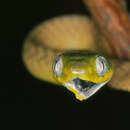en
names in breadcrumbs


According to Orlov and Ryabov (2002), the Green Cat-eyed Snake (Boiga cyanea) is known from Vietnam, Cambodia, Laos, Thailand, peninsular Malaysia, Myanmar, eastern India [West Bengal, Sikkim, Assam, Arunachal Pradesh, Meghalaya], Bhutan, Bangladesh, China [Yunnan])
Lincoln and Schranz (1975) reported on the hatching of a clutch of Boiga cyanea eggs in captivity. Of five eggs, two were infertile. The remaining three eggs hatched successfully after a total incubation period of 108-111 days. Although adults of this species are nearly all green, with a white throat and some light blue on the upper labials, the hatchlings were mostly reddish brown with a green head, white throat, and bright yellow upper labials. The hatchlings were 15 1/2 to 15 3/4 inches long. The red color of young was also noted and discussed by Golder (1987).
de Lisle (1984) reported on an incident in which one captive B. cyanea individual (120 cm long) accidentally struck and bit a second individual (155 cm) ~2cm behind its head while pursuing a mouse. The attacker held on for several minutes before the two snakes were separated. The larger snake became lethargic ~2 hours after being bitten. Its muscular weakness increased over the next two days, No other symptoms were noted, but the snake died 30 hours after being bitten.
Shea (2003) reported on rivalry between two male B. cyanea in captivity. The two males were observed locked in combat on the floor of the cage while a female was coiled on a branch above. The males entwined their elongate tails together in a tight and complex knot while their heads and mid and anterior portions of their bodies were used to compress the other to the floor in a slow twisting motion. The behavior was observed for ~ 10 minutes before the males separated.
Boiga cyanea, commonly known as the Green cat snake, is a colubrid snake species found in South Asia, China and South-east Asia.
Medium to large in length, slightly compressed, medium bodied snake with a moderately long tail. Head distinct from narrow neck with a rounded snout. Eyes large in size with vertically elliptical pupils. Dorsal scales smooth with single or double apical pits. Ventrals with a feeble lateral keels. Dorsal scale count usually 21 - 21 ( 23 ) - 15.[1] Its long prehensile tail makes it purely arboreal.
Dorsal color uniform green or green mixed with grayish or bluish. Belly color greenish or yellowish white. Top of the head usually similar to dorsal color or sometimes of brownish tint. Upper lip color yellowish; most of head scaled margined with black. Eyes golden brown.[2] Hatchlings are reddish brown with a green head. The color of the hatchlings starts to change after 8–9 months of age.
Length: Maximum: 190 cm.[3] Common: 115 cm.[4] (SVL. 87 cm.)
The green cat snake found in Bangladesh, Bhutan, Cambodia, China (Yunnan- part), India (Sikkim, Darjeeling & Jalpaiguri, West Bengal, Assam, Arunachal Pradesh, Andaman & Nicobar Islands), Laos, Malaysia (West), Myanmar, Nepal, Thailand (incl. Phuket) and Vietnam.
Habitat: Terrestrial & arboreal; inhabits primary and secondary forests, including montane zones, and can also be found at sea level in coastal forests.[5]
Habit: Nocturnal. Occasionally seen on the ground searching for prey. Very mild disposition, sluggish, and makes no attempt to escape when approached or when handled. Difficult to provoke into striking.[6] By day stays coiled up amongst tree branches, but by night actively hunts for prey.[7]
Diet: Carnivorous; feeds mainly on lizards. Also takes frogs, birds, rodents and also other snakes.[8] This rear fanged & mildly venomous snake can paralyze small prey. If threatened, it will become hostile and posture with a wide open mouth.

Reproduction: Oviparous; Eggs are laid approximately 42–50 days after mating and lays 7-14 eggs from late Winters to late Summers; incubation period approximately 85 days.[9]
Bites by this species not expected to cause medically significant effects and the only risk, probably small, local secondary infection. Patients presenting with bites by these snakes do not require medical attention, other than to check for infection and ensure tetanus immune status. Patients should be advised to return if local symptoms develop, suggesting secondary infection. Bites unlikely to cause more than mild to moderate local swelling & pain, occasionally local bruising, paresthesia/numbness, erythema or bleeding, but no necrosis and no systemic effects. While most cases will be minor, not requiring admission, some cases will be more severe, requiring admission and treatment, so assess carefully before early discharge.[10]
Boiga cyanea, commonly known as the Green cat snake, is a colubrid snake species found in South Asia, China and South-east Asia.